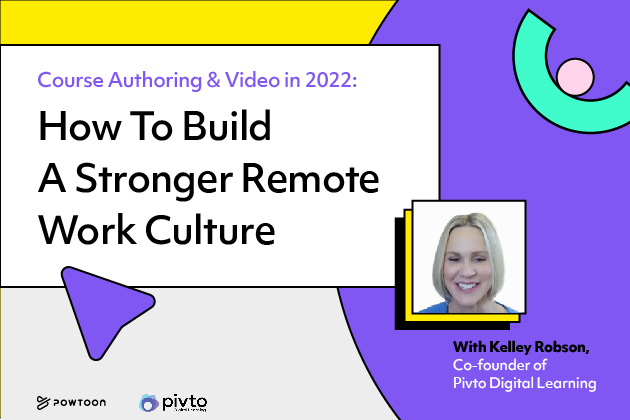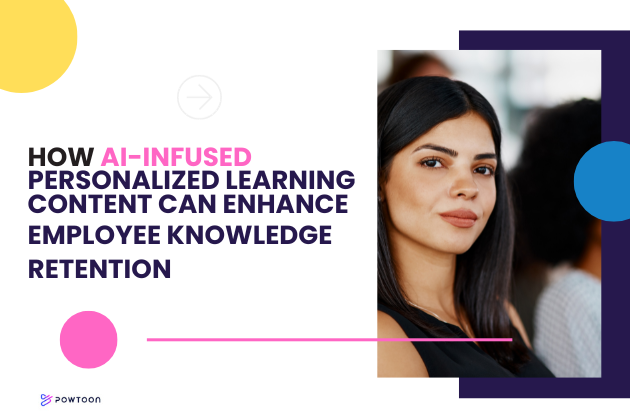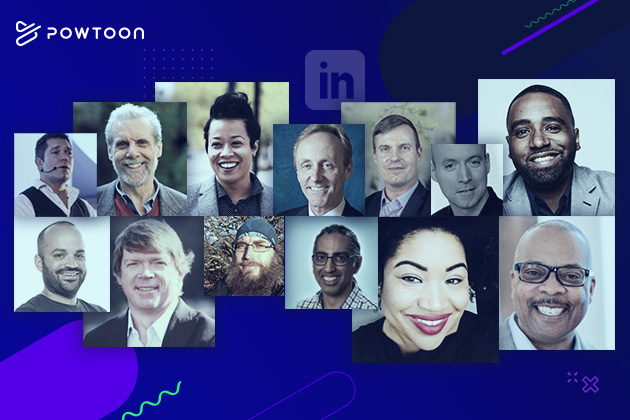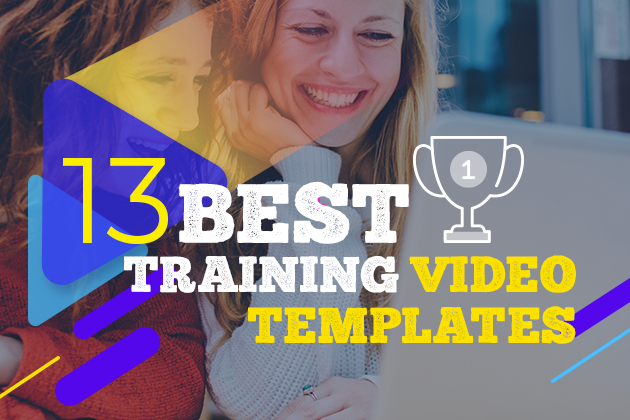
Course Authoring & Video in 2022: How to Build a Stronger Remote Work Learning Culture
Key trends and insights from Kelley Robson, co-founder of Pivto Digital Learning
Adapting to distributed teams, leveraging the talent in your organization, and delivering training in a manner your colleagues will actually enjoy and consume is no easy task. But a well trained and engaged workforce can pay dividends for your organization. How do you put your organization at the leading edge of learning?
More to the point: how do you leverage course authoring tools, like Articulate, and video creation platforms, like Powtoon, to create and deliver effective content no matter where your colleagues sit? Powtoon’s head of customer success, Daniel Nathan, sat down with Pivto Co-Founder, Kelley Robson to get an insider perspective on eLearning in 2022.
Kelley’s Background in Instructional Design
Daniel Nathan: Hi Kelly, Thank you so much for joining me. Give us a little bit of background as to your experience within instructional design.
Kelley Robson: I have about 20 years experience building and leading organizations. My training and development background included working for organizations like Siemens, GSK, and Baxter Healthcare.
One of my goals is to help my clients use digital media to make eLearning more impactful and, more importantly, drive your business needs. My team of instructional designers at Pivto are experts at creating eLearning that reflects the culture of organizations, which I think is super important.
We use a variety of tools to achieve those goals, and some of my favorite tools include:
- Articulate Storyline
- Adobe Premiere Pro
- 7Taps — a newer tool we’ve been using for micro learning
- Storyblocks — which integrates with Powtoon, and is great for stock video, music, and photos
- And of course, Powtoon
Why Video Is So Powerful for Learning
DN: Can you elaborate on why video is being harnessed as a medium for learning within companies?
KR: Video is a key component of developing a corporate culture for remote workforces. As we move into 2022, organizations are realizing that their employees are happier, and healthier too, working from home, saving on commute times, etc.
For the most part, we’ve accepted that getting everyone back in the office may not happen anytime soon, and people are going to remain remote. That’s going to be a long-term, permanent change to how we work.
In 2021, I think management was focused on having the right procedures and tools in place so they retained productivity. The big shift in 2022 is now we’re going to be a permanently fully-remote, or partially-remote organization. Given that, how can we develop a strong remote work culture? I think video is key.
Video is one of the strongest ways to engage, and is so much more impactful than a lot of the other techniques that I see out there. Whether it’s getting on zoom calls or sharing PowerPoint presentations, video is just really impactful.
Keep in mind that the brain processes video 60,000 times faster than text which is just truly amazing. And in 2021, 80% of all Internet traffic was video. That kind of engagement is important from a standpoint of building culture remotely. Video builds that trust.
So this is why at Pivto, we always add video to the courses we recreate, whether we’re doing it in storyline or stand-alone, because it’s the best way to build connections between the content instructors and learners.
Articulate storylines are great, but we’ve all gone through training that was mandatory, and it was really just an interactive PowerPoint where you click through it as fast as you can, check the box, and say, “I’ve done the training.”
We need to do better than that, and we can do better than that. Not only is video a key component to that effort, but it also allows your team to have a point of view, a bit of levity, and to make learning fun for people, rather than just a chore and something to get through. People just have come to expect video based content, and if you see just text-based training, it’s just not going to be engaging, and it’s not what people expect from world class organizations.
Emerging eLearning Trends in 2022
DN: Looking ahead into 2022, what are the best strategies that you’re seeing for eLearning? What kind of trends are you expecting to see?
KR: Well, I think the biggest trend that we’re seeing is what people have settled on calling The Great Resignation. Companies are asking themselves, “Now that this is happening, how can we attract and retain top talent?”
It’s clear that employees have changed their priorities. They want to work for companies that have a compelling business objective. But they also want to work in places that have strong social and environmental responsibility. They want to be shown that the companies that they’re working for have a commitment to take care of their mental and physical health. And they want to make sure that wherever they work is offering flexible work-from-home options.
According to recent research from Gartner, organizations spend on average, $2,500 per employee, per year on employee experience. And this is only expected to increase.
So your learning needs to reflect the culture of your organization, be fun and rewarding for employees to engage with, and most importantly, it needs to be available anytime, anywhere, from any device. Employees don’t want to have to get on a conference call at a specific time; they want to be able to engage with eLearning when they have time to fit it in their schedule, in small amounts of learning at a time, to help with retention.
2022’s eLearning Tech Stack
DN: You alluded earlier to the additional eLearning tools that you’re using. You named a few such as Articulate. How are you leveraging video with those tools to deliver your eLearning content?
KR: Sure. Firstly, Articulate makes it really easy to incorporate videos created with Powtoon. Really any MP4 file can be added into Articulate Storyline as a video block. You just add that in a drop down menu.
And you can make all those videos interactive as well. For instance, Articulate allows us to present learners a button that pops up over the video, where you can show hidden layers of content within. It’s really taking video to the next step, making it fully interactive for the learner.
Leveraging Video Throughout Your eLearning Strategy
DN: How do Learning & Development leaders leverage their video creation tools throughout their entire eLearning strategy?
KR: It’s important to start with the fact that learners are expecting eLearning to be like any other media that they consume. As a huge range of new design, animation and video tools become available on the market, such as Powtoon and Articulate, eLearning needs to be improved as well.
While the stories we tell in eLearning remain very important, people’s expectations of the quality and visual experience of the eLearning they consume are growing. They expect higher-quality content and higher content value, and Powtoon really makes that easy to deliver.
We can help build templates for our clients within Powtoon. We can help them build out the videos but then, instead of having to bring in a video expert or animation team when things change in their organizations — when titles change, when. structure changes, when their processes change, etc. — they can go in and make a quick edit to the Powtoons that we’ve created for them and have updated videos up and running in no time, instead of weeks or months.
That’s one of the most exciting things about Powtoon and some of these other tools: you can quickly, as an HR department or L&D specialist, create new videos weekly — not annually. Where it used to be you’d have one big eLearning module that you create once a year, now you can make smaller videos quickly, as needed, and at scale. That way your employees stay current and up to date with announcements, training, new software, or whatever you might be teaching them.
And as we discussed, learning on mobile devices is in demand in a way it hasn’t been previously. People are sharing their devices, working at home, perhaps on multiple devices, and they’re looking for tasks that they can complete in a more entertaining setting. Part of this phenomenon is driven by the fact that they’re consuming other content on those same devices, via YouTube, Netflix, or social media feeds, and they want to have a similar, more entertaining experience with their eLearning.
Value for Learners & Instructional Designers
DN: Could you elaborate further and tell us some of the additional value that you get from Powtoon’s video creation platform as an instructional designer.
KR: Good question. A lot of our clients have Powtoon licenses and they initially engaged with it because they were familiar with the animation capabilities and the character builder. The ability to craft your own characters is absolutely incredible because you can take the characters and make sure they’re on-brand. You can have them reflect a diverse workforce. And you really have no limit to the variations on the characters that you can create. It’s really cool to put those characters in the whiteboard or the infographic animation styles which have been core to Powtoon for years.
But I really also like the screen capture functionality that was recently added to Powtoon, because it’s just a great way to:
- Demonstrate software changes in an organization
- Produce step-by-step walkthroughs
- Hear directly from company leadership
- Greet new people, and celebrate success
Ultimately, the ability to create and edit video content quickly is also a key benefit. The video templates within Powtoon are just absolutely unbelievable. The collection is extensive, and new templates are always being updated. Anyone on the team can customize them to look like a completely original animation project — but they’re built on the power team templates.
DN: Kelley Robson, co-founder of Pivto Digital Learning, thank you so much for your time.
KR: Thanks Daniel, I appreciate it.
Ready to Add Powtoon to Your Instructional Design Stack?
Amazing insights and compelling trends: thank you to Kelley and the whole Pivto team.
2022 is the year to start amplifying up your teams’ creativity with your eLearning tech stack to deliver video that makes an impact. Talk to one of Powtoon’s experts to learn more about our Enterprise solution.
Click here to get started!
If you are interested in Pivto’s creative services using Powtoon, feel free to reach out to partner@powtoon.com to learn more.


![Digitizing Training: 4 Steps to Digital Transformation [SkyGuide]](https://www.powtoon.com/blog/wp-content/uploads/2019/09/BlogPost_4-Steps-Digital-Transformation_Blog-image_630x420.jpg)



